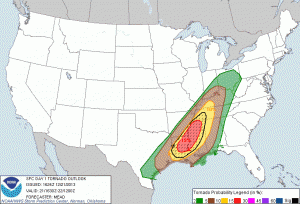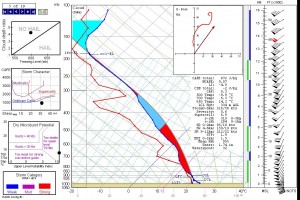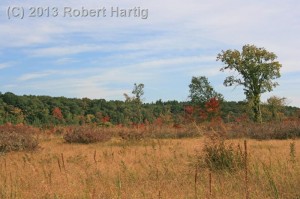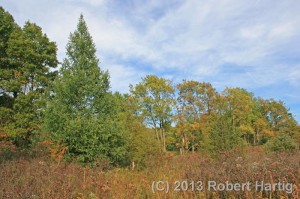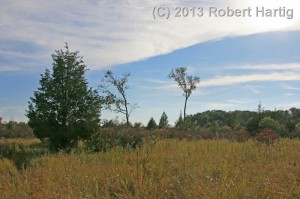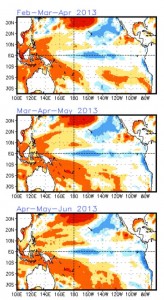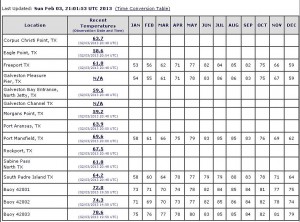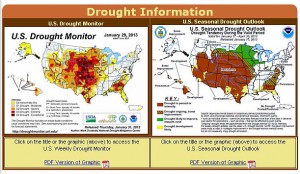Today is February 1, and let’s just say it: This winter is getting reeeaaaally old. Incursion after incursion of Arctic air. Snow, snow, snow. Cold, cold, cold–and I do mean cold. After Monday and Tuesday’s bitter, subzero bite, these mid-twenties temperatures that have moved in feel practically tropical.
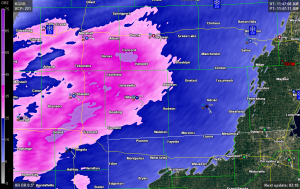 We’re presently under a winter weather advisory, with 3 to 5 inches of snow forecast through 10:00 p.m. around here and an inch more to the south and southeast along the I-94 corridor. And it’s wet snow–not as bad as initially expected, according to the latest KGRR forecast discussion, but still watery enough–and therefore heavy enough–to put added stress on flat roofs. Here’s a radar image from a few scans back. Look at all that gray! I hardly ever see returns that hit 40 dBZ with a winter storm, but a bit of interrogation revealed 49.5 dBZ over US-131 with this particular scan. And it appears to be all snow too, not a wintry mix. So yeah, I’d call that wet snow.
We’re presently under a winter weather advisory, with 3 to 5 inches of snow forecast through 10:00 p.m. around here and an inch more to the south and southeast along the I-94 corridor. And it’s wet snow–not as bad as initially expected, according to the latest KGRR forecast discussion, but still watery enough–and therefore heavy enough–to put added stress on flat roofs. Here’s a radar image from a few scans back. Look at all that gray! I hardly ever see returns that hit 40 dBZ with a winter storm, but a bit of interrogation revealed 49.5 dBZ over US-131 with this particular scan. And it appears to be all snow too, not a wintry mix. So yeah, I’d call that wet snow.
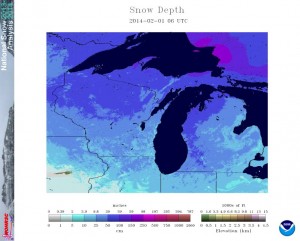 The thing is, this stuff just keeps coming. We all know that by now. I haven’t seen a winter this snowy since 2009, maybe even before that, since . . . since . . . well, I don’t know when. As you can see from today’s snow depth map, there’s a strip running through my area along the western side of Michigan where the snow depth reportedly exceeds 20 inches. We’re not talking about how much snow has actually fallen this winter, just how much of it is presently sitting on the ground. Twenty inches. I can testify that around here, it’s not hard to find places where it’s nearly up to my knees. Heck, just along the sidewalk outside my apartment, the snowblower has neatly carved a minor canyon along the edge of the featureless white expanse which, if my memory is accurate, used to be what is called a “lawn.”
The thing is, this stuff just keeps coming. We all know that by now. I haven’t seen a winter this snowy since 2009, maybe even before that, since . . . since . . . well, I don’t know when. As you can see from today’s snow depth map, there’s a strip running through my area along the western side of Michigan where the snow depth reportedly exceeds 20 inches. We’re not talking about how much snow has actually fallen this winter, just how much of it is presently sitting on the ground. Twenty inches. I can testify that around here, it’s not hard to find places where it’s nearly up to my knees. Heck, just along the sidewalk outside my apartment, the snowblower has neatly carved a minor canyon along the edge of the featureless white expanse which, if my memory is accurate, used to be what is called a “lawn.”
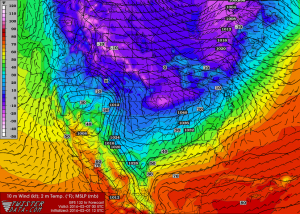 How about one more image? Look and groan, because all this glorious wintry nastiness doesn’t look to be retreating anytime soon. You’re looking at the 132-hour forecast for the surface temperature. Doesn’t that look inviting, so full of hope and promise? Tomorrow is Groundhog Day, and I’m telling you right now, that little cretin had better not show his face anywhere in my vicinity or I will send him into permanent hibernation.
How about one more image? Look and groan, because all this glorious wintry nastiness doesn’t look to be retreating anytime soon. You’re looking at the 132-hour forecast for the surface temperature. Doesn’t that look inviting, so full of hope and promise? Tomorrow is Groundhog Day, and I’m telling you right now, that little cretin had better not show his face anywhere in my vicinity or I will send him into permanent hibernation.
If there’s one good thing about this winter from a personal perspective, it’s that it has inspired me to learn about winter forecasting. There’s certainly every opportunity to do so, and plenty of incentive. So I’ve learned a few new terms. Try this one on for size: heterogeneous nucleation. I like that one. Or how about this: DGZ, which stands for dendritic growth zone, the temperature range between -12 and -18 degrees Celsius wherein a saturated layer produces snowflakes. Got that? I’m starting to, along with a deeper appreciation for my RAOB software program.
But I’d still be glad to see all this snow and cold go bye-bye, and I’ll bet I’m not the only one. Well, well . . . buck up, ladies and gentlemen: meteorological spring is on the way. I just have a hunch it won’t be here March 1. It’s arrival time may be delayed by snow.
What about you? Are you a winter lover or a winter Grinch–or has this winter turned you from one into the other? How do you think this crazy-cold, uber-snowy weather might affect the spring storm season? Drop a comment and share your thoughts.
